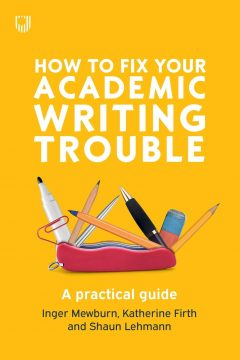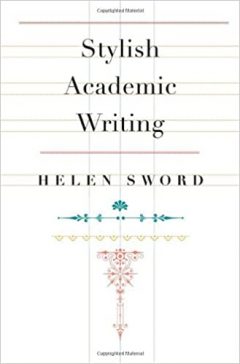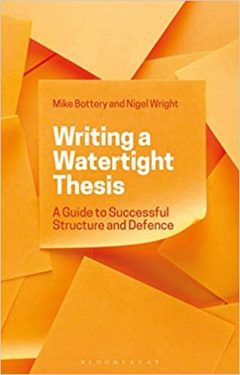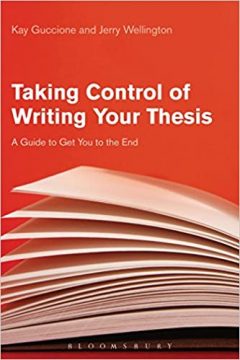This page is dedicated to brief reviews of books on the writing process. Some of the books below address issues specific to graduate students such as dissertation/thesis planning and writing, others address issues pertinent to academic writing more broadly.
We hope these reviews will help you select the resources that best suit your needs.
Enjoy browsing through our bookshelf!
By Helen Sword
Harvard University Press, 2012
In Stylish Academic Writing, Helen Sword tackles a question often posed by readers of academic papers and books: why do many academic authors fail to write engaging academic prose? Thus, the essential issue Sword targets is the ever-present, “massive gap between what most readers consider to be good writing and what academics typically produce and publish.”
Her response, one which she supports with rigorous research and cogent argument, is actually the book’s two-pronged thesis: first, “elegant ideas deserve elegant expression” and, second, academic conventions, though appearing incredibly rigid at first glance, do allow academic writers enough flexibility to write and structure their texts creatively. This injection of creativity animates the text and transforms the reading experience from a chore to be avoided if at all possible to an experience characterized by engagement and pleasure.
In line with her emphasis on creativity, Sword is not prescriptive. She delves into the ways in which writers can work on improving “elements of style” such as titles, sentences, and structure—in addition to including a list of actionable tips at the end of each chapter. However, she does not provide a one-size-fits-all writing guide which describes how your own academic writing should look like. According to Sword, “academic writing is a process of making intelligent choices, not of following rigid rules.” She informs writers of the choices available and encourages them to think hard about how they express ideas and why they express them the way they do. These choices will essentially make or break the style of the text.
Thus, if you come to this book expecting to receive advice on how to write a literature review or a methodology section, you will be disappointed. Sword assumes her readers know the conventions but need help improving their writing style. In short, the emphasis here is on stylish, not on academic writing as such.
Overall, this book is a great resource for graduate students, partly because many of them have yet to internalize the disciplinary conventions so deeply. This also means that if you are new to academic writing and want to learn both the basic conventions and how to write stylish academic prose, a good approach would be to read this book alongside a more traditional guidebook about academic writing.
Stylish Academic Writing is highly informative, witty, an all-around pleasure to read. It demonstrates to academic writers that they do not have to choose between convention and style. Rather, the real formula goes as follows: convention plus creativity equals style.
A Guide to Successful Structure and Defence
By Mike Bottery and Nigel Wright
Bloomsbury Academic, 2019
One of the most challenging aspects of writing a thesis is deciding how to plan and structure its various components. This is precisely the focus of Writing a Watertight Thesis by Mike Bottery and Nigel Wright. According to the authors, this guide explains “how to set up a thesis structure and how to maintain it throughout the doctoral journey.”
Though using terminology common at UK universities, the authors emphasize that their approach is nonetheless “helpful under most doctoral rubrics whether the research takes place in the UK, Hong Kong, Canada, the Czech Republic, or in most other countries.”
The other claim to wide applicability is related to the approach itself. Bottery and Wright indicate that their formula would work for all doctoral students, irrespective of discipline. All doctoral students do stand to receive some benefit from reading this guide, but this claim is somewhat questionable given that the formula presented here is clearly influenced by approaches typically used in the social sciences.
The key to their approach is building a thesis structure based on the research questions and sub-questions. Using the research questions as the main structuring principle would lead to sound arrangement of the thesis components, thus ensuring that all components are linked effectively. This formula is perhaps most beneficial in that it draws attention to an all-too-common pitfall: a thesis structure characterized by logical leaps, one lacking in cohesiveness and synthesis.
If you follow their formula, the authors promise, you will produce a watertight thesis which cannot by sunk by examiners—at least not on structural grounds. This approach, it must be mentioned, seems mechanical and highly restrictive. The authors clearly favour tried and tested (read: safe) approaches over creative or innovative ones. While the approach could be described as rigid or limiting, it is still possible to use this book to learn basic structuring principles and then divert from those principles as you see fit.
The above is especially true for those who know little about thesis planning and writing. The authors neither assume that the reader has much prior knowledge, nor do they shy away from addressing the most basic elements of thesis writing such as constructing good research questions, the different epistemologies informing how researchers view knowledge production, and the positionality of the researcher. In addition, they discuss best practices with respect to writing literature reviews and methodologies.
The chapters of Writing a Watertight Thesis move chronologically—from the proposal to the defence and beyond. While this is definitely a good guide to consult no matter where you happen to be on that chronological arc, it is best to do so alongside other guides which provide more flexible and innovative approaches.
A Guide to Get You to the End
By Kay Guccione and Jerry Wellington
Bloomsbury Academic, 2017
Taking Control of Your Thesis by Kay Guccione and Jerry Wellington begins with a discussion of the different models informing how doctoral training is done. In the old model, all facets of doctoral training are determined by the close relationship formed between the supervisor and the doctoral candidate. While this model involves figuring out the secrets of this relationship and managing its idiosyncratic nature, the new model requires the doctoral candidate to assume control of the process and build the capacity to draw on a network of individuals both within and outside the university.
The authors align themselves with the new model. This explains why their book is influenced by the paradigm of coaching rather than by the traditional guidebook structure which tends to lean heavily on technical tips and clearly delineated steps. After all, while the thesis project is a collaborative venture, it is you who should take control of your thesis process.
If so, what does “taking control” entail? Broadly speaking, taking control of one’s own thesis means understanding each step conceptually, reflecting on it critically, and drawing on the experience and knowledge of a wide network of mentors to improve practices. In short, Taking Control of Your Thesis shows you how all that works through an examination of the thesis process, an examination which maps out the different considerations, the different approaches and expectations individuals bring to it.
The consideration and approaches include using the tools of project management to bring your thesis under control—setting goals, determining milestones, getting stakeholders on board, and so on. Other considerations relate to the processes of writing and thinking as well as the processes of reading and writing. Because writing is a form of thinking, for instance, these processes should not be treated as distinct activities but as “partner processes.” In other words, you should not have to “finish” thinking before you start writing. Reading and writing, on the other hand, are “joint functions” which means reading never fully stops until the writing is completely done. Sometimes you do have to devote the bulk of your time for writing, but you should keep reviewing the literature up to the very last minute.
In addition to illuminating ways of thinking about the thesis process and its components, Taking Control of Your Thesis provides specific tools and insights. These include insights about finding and recruiting mentors, starting writing groups, examining the literature, coaching oneself, negotiating the feedback process, as well as dealing with challenges such as feeling “stuck,” isolation, burnout, and anxiety.
Writing a thesis requires understanding its components and reflecting on one’s own practices. Taking Control of Your Thesis can help you on both fronts.
How to Fix Your Academic Writing Trouble
A Practical Guide
By Inger Mewburn, Katherine Firth, and Shaun Lehmann
Open University Press, 2019
Graduate students seeking advice on academic writing have access to a growing list of books that guide them through the process of becoming strong academic writers. Unlike many such guidebooks, which tend lay out the process from start to end, How to Fix Your Academic Writing Trouble: A Practical Guide follows a different approach: the authors organize their addition to the genre around the typical feedback graduate students receive, before providing techniques and suggestions as to how to fix these common issues. According to the authors, this is not a “how to” manual but a recipe book whose chapters address common, frustratingly vague feedback such as “Your Writing Doesn’t Sound Very Academic,” “Where’s Your Evidence for This?” and “Your Writing Doesn’t Flow.”
Though presented as “a practical guide,” the book’s most refreshing feature lies in the authors’ capacity to provide both practical, concrete advice as well as a high-level treatment that helps the reader appreciate the historical and linguistic roots of the feedback they receive. By doing so, they help readers understand their writing troubles at the conceptual level before offering them concrete suggestions as to how those troubles might be remedied.
For instance, the authors explain the reason non-native speakers of English tend to receive feedback related to the vagueness of their prose. Through a discussion of high-context vs. low-context languages, the authors explain that English, unlike many other languages, is a low-context language that requires writers to take into account that “the recipient of the communication is not expected to work hard to understand what they are hearing or reading.” In other words, “if you are told your writing is vague, you are [possibly] writing in a higher-context mode than the reader.” Having provided a conceptual explanation of this issue, the authors then go through a list of practical techniques that allow writers to write in a clear, crisp, and structured manner.
Another noteworthy example of this feature is the discussion on how the Norman Conquest of England created a a cultural and linguistic split between Latinate and Germanic words: words of Latinate origin became associated with learned discourse, whereas those of Germanic origin became associated with everyday language. Thus, if an aspiring academic writer is told their writing “doesn’t sound very academic” or that it is “chatty or conversational,” one technique the writer could use involves changing Germanic words with Latinate ones: large instead of big, advantageous instead of good, consider instead of think about. You don’t give participants forms to fill in; you provide them with forms to complete—a simple fix to what might seem as an intractable problem. The authors are careful to caution against overusing this technique so as not to sound stilted or pompous. They also caution against dealing with issues related to tone through making one’s writing unnecessarily complex—a common response to this type of critique.
The authors of How to Fix Your Academic Writing Trouble—Inger Mewburn, Katherine Firth, and Shaun Lehmann—have direct experience helping graduate students make the transition from competent academic writers to good academic writers. If you decide to pick up this book, you will have access to their three decades of cumulative experience helping junior academic writers become better at what they do.


